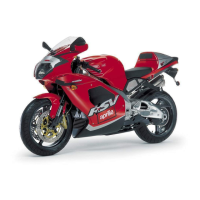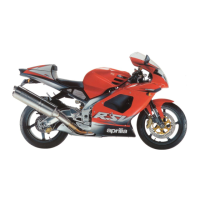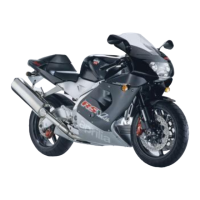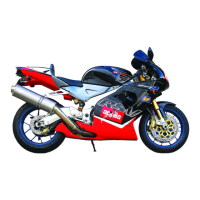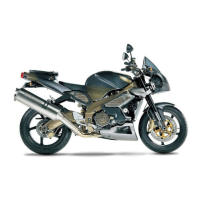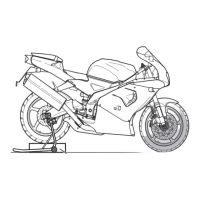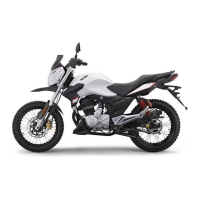Do you have a question about the APRILIA ETV mille and is the answer not in the manual?
Outlines general safety precautions and important information to follow during repair and disassembly procedures.
Provides guidelines to follow before starting the disassembly of any motorcycle components, emphasizing cleanliness.
Details procedures and precautions for safely disassembling motorcycle components, including marking connections and cleaning parts.
Offers guidance on reassembling components, stressing the importance of using correct parts and procedures for safety.
Provides critical warnings about handling brake fluid, its irritant properties, and potential damage to parts.
Provides a detailed chart specifying maintenance tasks and intervals for all key motorcycle components.
Provides instructions for checking and topping up the engine oil level, emphasizing correct procedure and avoiding overfilling.
Details the step-by-step process for changing the engine oil and filter, including torque settings and precautions.
Guides on checking and topping up the coolant level, highlighting safety precautions and correct procedures.
Provides instructions for checking and topping up the front brake fluid level, emphasizing safety and correct procedures.
Guides on checking and topping up the rear brake fluid level, with emphasis on safety and correct procedures.
Details the process for checking and topping up the clutch fluid level, including important safety warnings.
Explains the procedure for bleeding the brake circuits to remove air and ensure proper braking efficiency.
Details the process for bleeding the clutch system to remove air and ensure proper operation.
Provides a quick inspection procedure to determine the wear level of brake pads and when replacement is necessary.
Advises on inspecting tyre tread for wear and damage, emphasizing the importance of timely replacement for safety.
Provides step-by-step instructions for safely removing the entire engine from the motorcycle frame.
Outlines the procedure for reinstalling the engine into the motorcycle frame, reversing the removal steps.
Details the procedure for removing the fuel pump assembly, including necessary precautions and torque settings.
Details the procedure for removing the fuel pump assembly, including precautions for electrical wires and clips.
Explains how the on-board computer manages engine operation for optimal ignition and fuel injection.
Details the procedure for removing the complete throttle body assembly, including disconnecting various components.
Details the procedure for removing the radiator, including draining coolant and disconnecting hoses.
Guides on checking the battery voltage and charge voltage at 4000 rpm to ensure proper operation of the charge system.
Guides on troubleshooting common problems related to the injection system, checks, and tests for various components.
Provides steps for initial troubleshooting of the ignition/injection system by checking the display and battery status.
Explains the operational logic of the safety lockout system based on transmission, side stand, and clutch lever positions.
Guides on testing the air temperature sensor by measuring resistance and checking instrument panel readings.
Details the procedure for replacing headlight bulbs, including high beam, low beam, and parking lights, with safety precautions.
Provides detailed instructions and safety precautions for the first-time installation and activation of the battery electrolyte.
Guides on checking and replacing fuses, emphasizing the use of correct ratings and identifying blown fuses.
Provides a troubleshooting guide for engine-related issues, listing common problems, possible causes, and remedies.
Guides on troubleshooting lack of spark by checking fuses, spark plugs, and ignition system components.
Lists detailed specifications for the front braking system, including disc thickness, diameter, and pad types.
Explains the function of the anti-lock brake system in preventing wheel lockout and ensuring stability.
| Brand | APRILIA |
|---|---|
| Model | ETV mille |
| Category | Motorcycle |
| Language | English |



